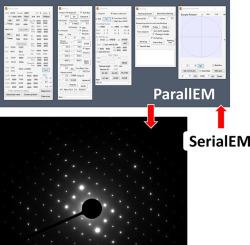Journal of Structural Biology ( IF 3 ) Pub Date : 2020-06-13 , DOI: 10.1016/j.jsb.2020.107549 Kiyofumi Takaba 1 , Saori Maki-Yonekura 1 , Koji Yonekura 2

|
A semi-automated protocol has been developed for rotational data collection of electron diffraction patterns by combined use of SerialEM and ParallEM, where SerialEM is used for positioning of sample crystals and ParallEM for rotational data collection. ParallEM calls standard camera control software through an AutoIt script, which adapts to software operational changes and to new GUI programs guiding other cameras. Development included periodic flashing and pausing of data collection during overnight or day-long recording with a cold field-emission beam. The protocol proved to be efficient and accurate in data collection of large-scale rotational series from two JEOL electron microscopes, a general-purpose JEM-2100 and a high-end CRYO ARM 300. Efficiency resulted from simpler steps and task specialization. It is possible to collect 12–20 rotational series from ∼ -68° to ∼ 68° at a rotation speed of 1° /s in one hour without human supervision.
中文翻译:

使用 ParallEM 和 SerialEM 收集旋转电子衍射的大型数据集。
通过结合使用 SerialEM 和 ParallEM,开发了一种用于电子衍射图案旋转数据收集的半自动协议,其中 SerialEM 用于样品晶体的定位,ParallEM 用于旋转数据收集。ParallEM 通过 AutoIt 脚本调用标准相机控制软件,该脚本适应软件操作变化和指导其他相机的新 GUI 程序。开发包括使用冷场发射光束在夜间或全天记录期间定期闪烁和暂停数据收集。该协议在来自两台 JEOL 电子显微镜、一台通用 JEM-2100 和一台高端 CRYO ARM 300 的大规模旋转系列数据收集中被证明是高效和准确的。效率源于更简单的步骤和任务专业化。


























 京公网安备 11010802027423号
京公网安备 11010802027423号